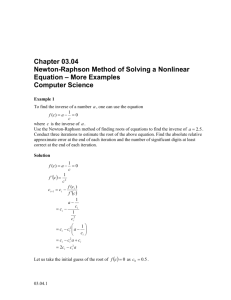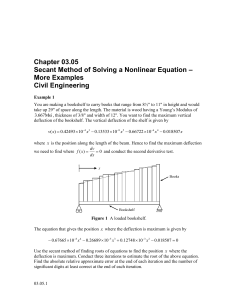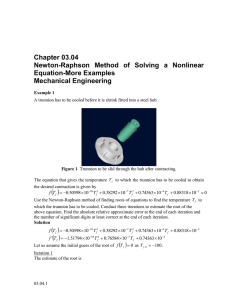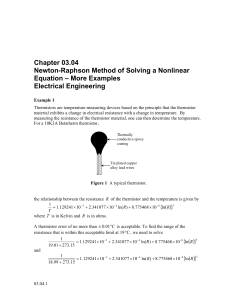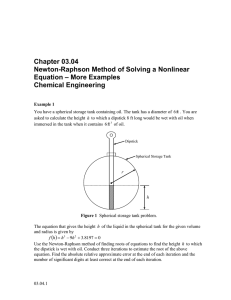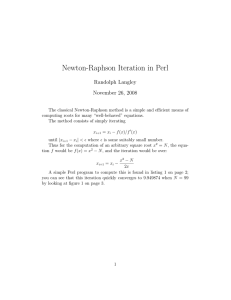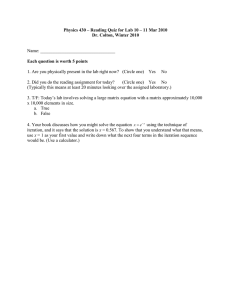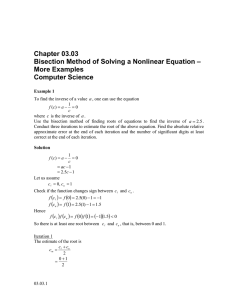Newton-Raphson Method Example: Bookshelf Deflection
advertisement
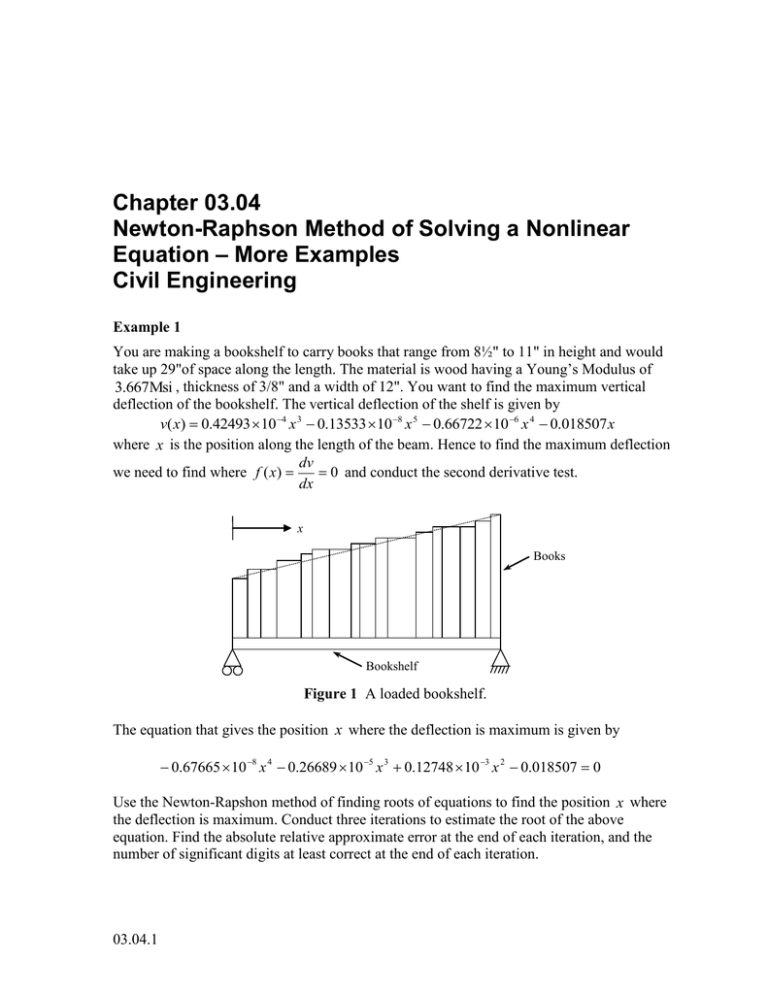
Chapter 03.04 Newton-Raphson Method of Solving a Nonlinear Equation – More Examples Civil Engineering Example 1 You are making a bookshelf to carry books that range from 8½" to 11" in height and would take up 29"of space along the length. The material is wood having a Young’s Modulus of 3.667Msi , thickness of 3/8" and a width of 12". You want to find the maximum vertical deflection of the bookshelf. The vertical deflection of the shelf is given by v( x) 0.42493 10 4 x 3 0.13533 10 8 x 5 0.66722 10 6 x 4 0.018507 x where x is the position along the length of the beam. Hence to find the maximum deflection dv 0 and conduct the second derivative test. we need to find where f ( x) dx x Books Bookshelf Figure 1 A loaded bookshelf. The equation that gives the position x where the deflection is maximum is given by 0.67665 10 8 x 4 0.26689 10 5 x 3 0.12748 10 3 x 2 0.018507 0 Use the Newton-Rapshon method of finding roots of equations to find the position x where the deflection is maximum. Conduct three iterations to estimate the root of the above equation. Find the absolute relative approximate error at the end of each iteration, and the number of significant digits at least correct at the end of each iteration. 03.04.1 03.04.2 Chapter 03.04 Solution f x 0.67665 10 8 x 4 0.26689 10 5 x 3 0.12748 10 3 x 2 0.018507 0 f x 2.7066 10 8 x 3 0.80067 10 5 x 2 0.25496 10 3 x 0 Let us take the initial guess of the root of f x 0 as x0 10. Iteration 1 The estimate of the root is f x0 x1 x0 f x0 0.67665 10 8 (10) 4 0.26689 10 5 (10) 3 0.12748 10 3 (10) 2 0.018507 10 8 3 5 2 2.7066 10 (10) 0.80067 10 (10) 0.25496 10 3 (10) 8.4956 10 3 1.7219 10 3 10 4.9339 14.934 The absolute relative approximate error a at the end of Iteration 1 is 10 a x1 x0 100 x1 14.934 10 100 14.934 33.038% The number of significant digits at least correct is 0, as you need an absolute relative approximate error of less than 5% for one significant digit to be correct in your result. Iteration 2 The estimate of the root is f x1 x 2 x1 f x1 0.67665 10 8 (14.934) 4 0.26689 10 5 (14.934) 3 0.12748 10 3 (14.934) 2 0.018507 14.934 8 3 5 2 2.7066 10 (14.934) 0.80067 10 (14.934) 0.25496 10 3 (14.934) 4 6.9829 10 14.934 1.9317 10 3 14.934 0.36149 14.572 The absolute relative approximate error a at the end of Iteration 2 is Newton-Raphson Method – More Examples: Civil Engineering a 03.04.3 x2 x1 100 x2 14.572 14.934 100 14.572 2.4806% The number of significant digits at least correct is 1, because the absolute relative approximate error is less than 5% . Iteration 3 The estimate of the root is f x2 x3 x 2 f x 2 0.67665 10 8 (14.572) 4 0.26689 10 5 (14.572) 3 0.12748 10 3 (14.572) 2 0.018507 14.572 8 3 5 2 2.7066 10 (14.572) 0.80067 10 (14.572) 0.25496 10 3 (14.572) 9 4.7078 10 14.572 1.9314 10 3 14.572 2.4375 10 6 14.572 The absolute relative approximate error a at the end of Iteration 3 is a x3 x 2 100 x3 14.572 14.572 100 14.572 1.6727 10 5 Hence the number of significant digits at least correct is given by the largest value of m for which a 0.5 10 2m 1.6727 10 5 0.5 10 2 m 3.3454 10 5 10 2 m log 3.3454 10 5 2 m m 2 log 3.3454 10 5 6.4756 So m6 The number of significant digits at least correct in the estimated root 14.572 is 6. 03.04.4 Chapter 03.04 NONLINEAR EQUATIONS Topic Newton-Raphson Method-More Examples Summary Examples of Newton-Raphson Method Major Civil Engineering Authors Autar Kaw Date July 12, 2016 Web Site http://numericalmethods.eng.usf.edu

